Dry Reforming of Methane on NiCu and NiPd Model Systems: Optimization of Carbon Chemistry
Abstract
:1. Introduction
2. Results and Discussion
2.1. Model Catalyst Characterization
2.1.1. Characterization of the NiCu Bulk-Intermetallic Catalysts
2.1.2. Characterization of the NiPd Bulk-Intermetallic Catalyst
2.2. Catalytic Testing via Temperature-Programmed DRM Experiments
2.3. Characterization after DRM Reaction
3. Materials and Methods
3.1. Model Catalyst Preparation
3.2. Modular High Vacuum Chamber for Physical Vapor Deposition (PVD)
3.3. Combined XPS/AES/LEIS-High Pressure Batch Reactor Setup
3.4. XPS Setup for Depth Profile Studies
3.5. Details of XPS Analysis
4. Conclusions
Author Contributions
Funding
Data Availability Statement
Acknowledgments
Conflicts of Interest
References
- Al-Mamoori, A.; Krishnamurthy, A.; Rownaghi, A.A.; Rezaei, F. Carbon Capture and Utilization Update. Energy Technol. 2017, 5, 834–849. [Google Scholar] [CrossRef] [Green Version]
- Kätelhön, A.; Meys, R.; Deutz, S.; Suh, S.; Bardow, A. Climate change mitigation potential of carbon capture and utilization in the chemical industry. Proc. Natl. Acad. Sci. USA 2019, 116, 11187–11194. [Google Scholar] [CrossRef] [Green Version]
- Baena-Moreno, F.M.; Rodríguez-Galán, M.; Vega, F.; Alonso-Fariñas, B.; Vilches Arenas, L.F.; Navarrete, B. Carbon capture and utilization technologies: A literature review and recent advances. Energy Sources Part A Recovery Util. Environ. Eff. 2019, 41, 1403–1433. [Google Scholar] [CrossRef]
- Wittich, K.; Krämer, M.; Bottke, N.; Schunk, S.A. Catalytic Dry Reforming of Methane: Insights from Model Systems. ChemCatChem 2020, 12, 2130–2147. [Google Scholar] [CrossRef]
- Gao, J.; Hou, Z.; Lou, H.; Zheng, X. Dry (CO2) Reforming. In Fuel Cells: Technologies for Fuel Processing; Elsevier: Amsterdam, The Netherlands, 2011; pp. 191–221. ISBN 978-0-444-53563-4. [Google Scholar]
- Ross, J.R.H. Natural gas reforming and CO2 mitigation. Catal. Today 2005, 100, 151–158. [Google Scholar] [CrossRef]
- Hu, Y.H.; Ruckenstein, E. Catalytic Conversion of Methane to Synthesis Gas by Partial Oxidation and CO2 Reforming. In Advances in Catalysis; Elsevier: Amsterdam, The Netherlands, 2004; pp. 297–345. ISBN 978-0-12-007848-6. [Google Scholar]
- Laosiripojana, N.; Assabumrungrat, S. Catalytic steam reforming of methane, methanol, and ethanol over Ni/YSZ: The possible use of these fuels in internal reforming SOFC. J. Power Sources 2007, 163, 943–951. [Google Scholar] [CrossRef]
- Rostrup-Nielsen, J.R. Syngas in perspective. Catal. Today 2002, 71, 243–247. [Google Scholar] [CrossRef]
- Rostrup-Nielsen, J.R.; Hansen, J.H.B. CO2-Reforming of Methane over Transition Metals. J. Catal. 1993, 144, 38–49. [Google Scholar] [CrossRef]
- Bradford, M.C.J.; Vannice, M.A. CO2 Reforming of CH4. Catal. Rev. 1999, 41, 1–42. [Google Scholar] [CrossRef]
- Pakhare, D.; Spivey, J. A review of dry (CO2) reforming of methane over noble metal catalysts. Chem. Soc. Rev. 2014, 43, 7813–7837. [Google Scholar] [CrossRef]
- Giehr, A.; Maier, L.; Schunk, S.A.; Deutschmann, O. Thermodynamic Considerations on the Oxidation State of Co/γ-Al2O3 and Ni/γ-Al2O3 Catalysts under Dry and Steam Reforming Conditions. ChemCatChem 2018, 10, 751–757. [Google Scholar] [CrossRef]
- Kim, W.Y.; Jang, J.S.; Ra, E.C.; Kim, K.Y.; Kim, E.H.; Lee, J.S. Reduced perovskite LaNiO3 catalysts modified with Co and Mn for low coke formation in dry reforming of methane. Appl. Catal. A Gen. 2019, 575, 198–203. [Google Scholar] [CrossRef]
- Ginsburg, J.M.; Piña, J.; El Solh, T.; de Lasa, H.I. Coke Formation over a Nickel Catalyst under Methane Dry Reforming Conditions: Thermodynamic and Kinetic Models. Ind. Eng. Chem. Res. 2005, 44, 4846–4854. [Google Scholar] [CrossRef]
- Tavares, M.T.; Alstrup, I.; Bernardo, C.A.A. Coking and decoking during methanation and methane decomposition on Ni-Cu supported catalysts. Mater. Corros. 1999, 50, 681–685. [Google Scholar] [CrossRef]
- Zhang, J.; Wang, H.; Dalai, A. Development of stable bimetallic catalysts for carbon dioxide reforming of methane. J. Catal. 2007, 249, 300–310. [Google Scholar] [CrossRef]
- Yu, M.; Zhu, Y.-A.; Lu, Y.; Tong, G.; Zhu, K.; Zhou, X. The promoting role of Ag in Ni-CeO2 catalyzed CH4-CO2 dry reforming reaction. Appl. Catal. B Environ. 2015, 165, 43–56. [Google Scholar] [CrossRef]
- García-Diéguez, M.; Pieta, I.S.; Herrera, M.C.; Larrubia, M.A.; Alemany, L.J. RhNi nanocatalysts for the CO2 and CO2+H2O reforming of methane. Catal. Today 2011, 172, 136–142. [Google Scholar] [CrossRef]
- García-Diéguez, M.; Finocchio, E.; Larrubia, M.Á.; Alemany, L.J.; Busca, G. Characterization of alumina-supported Pt, Ni and PtNi alloy catalysts for the dry reforming of methane. J. Catal. 2010, 274, 11–20. [Google Scholar] [CrossRef]
- Menegazzo, F.; Signoretto, M.; Pinna, F.; Canton, P.; Pernicone, N. Optimization of bimetallic dry reforming catalysts by temperature programmed reaction. Appl. Catal. A Gen. 2012, 439–440, 80–87. [Google Scholar] [CrossRef]
- Foppa, L.; Margossian, T.; Kim, S.M.; Müller, C.; Copéret, C.; Larmier, K.; Comas-Vives, A. Contrasting the Role of Ni/Al2O3 Interfaces in Water-Gas Shift and Dry Reforming of Methane. J. Am. Chem. Soc. 2017, 139, 17128–17139. [Google Scholar] [CrossRef]
- Wei, J.; Iglesia, E. Isotopic and kinetic assessment of the mechanism of reactions of CH4 with CO2 or H2O to form synthesis gas and carbon on nickel catalysts. J. Catal. 2004, 224, 370–383. [Google Scholar] [CrossRef]
- Medford, A.J.; Vojvodic, A.; Hummelshøj, J.S.; Voss, J.; Abild-Pedersen, F.; Studt, F.; Bligaard, T.; Nilsson, A.; Nørskov, J.K. From the Sabatier principle to a predictive theory of transition-metal heterogeneous catalysis. J. Catal. 2015, 328, 36–42. [Google Scholar] [CrossRef] [Green Version]
- Song, K.; Lu, M.; Xu, S.; Chen, C.; Zhan, Y.; Li, D.; Au, C.; Jiang, L.; Tomishige, K. Effect of alloy composition on catalytic performance and coke-resistance property of Ni-Cu/Mg(Al)O catalysts for dry reforming of methane. Appl. Catal. B Environ. 2018, 239, 324–333. [Google Scholar] [CrossRef]
- Halliche, D.; Bouarab, R.; Cherifi, O.; Bettahar, M.M. Carbon dioxide reforming of methane on modified Ni/α-Al2O3 catalysts. Catal. Today 1996, 29, 373–377. [Google Scholar] [CrossRef]
- Yu, X.; Zhang, F.; Chu, W. Effect of a second metal (Co, Cu, Mn or Zr) on nickel catalysts derived from hydrotalcites for the carbon dioxide reforming of methane. RSC Adv. 2016, 6, 70537–70546. [Google Scholar] [CrossRef]
- Wohlrab, S.; Ehrlich, D.; Wambach, J.; Kuhlenbeck, H.; Freund, H.-J. Promoter action of alkali in the activation of CO2 on Pd(111): A HREELS case study. Surf. Sci. 1989, 220, 243–252. [Google Scholar] [CrossRef]
- Ogihara, H.; Takenaka, S.; Yamanaka, I.; Tanabe, E.; Genseki, A.; Otsuka, K. Formation of highly concentrated hydrogen through methane decomposition over Pd-based alloy catalysts. J. Catal. 2006, 238, 353–360. [Google Scholar] [CrossRef]
- Steinhauer, B.; Kasireddy, M.R.; Radnik, J.; Martin, A. Development of Ni-Pd bimetallic catalysts for the utilization of carbon dioxide and methane by dry reforming. Appl. Catal. A Gen. 2009, 366, 333–341. [Google Scholar] [CrossRef]
- Singha, R.K.; Shukla, A.; Sandupatla, A.; Deo, G.; Bal, R. Synthesis and catalytic activity of a Pd doped Ni–MgO catalyst for dry reforming of methane. J. Mater. Chem. A 2017, 5, 15688–15699. [Google Scholar] [CrossRef]
- Paksoy, A.I.; Caglayan, B.S.; Aksoylu, A.E. A study on characterization and methane dry reforming performance of Co–Ce/ZrO2 catalyst. Appl. Catal. B Environ. 2015, 168–169, 164–174. [Google Scholar] [CrossRef]
- Singha, R.K.; Yadav, A.; Shukla, A.; Iqbal, Z.; Pendem, C.; Sivakumar, K.; Bal, R. Promoting Effect of CeO2 and MgO for CO2 Reforming of Methane over Ni-ZnO Catalyst. ChemistrySelect 2016, 1, 3075–3085. [Google Scholar] [CrossRef]
- Singha, R.K.; Yadav, A.; Agrawal, A.; Shukla, A.; Adak, S.; Sasaki, T.; Bal, R. Synthesis of highly coke resistant Ni nanoparticles supported MgO/ZnO catalyst for reforming of methane with carbon dioxide. Appl. Catal. B Environ. 2016, 191, 165–178. [Google Scholar] [CrossRef]
- Lee, J.-H.; Lee, E.-G.; Joo, O.-S.; Jung, K.-D. Stabilization of Ni/Al2O3 catalyst by Cu addition for CO2 reforming of methane. Appl. Catal. A Gen. 2004, 269, 1–6. [Google Scholar] [CrossRef]
- Chen, H.-W.; Wang, C.-Y.; Yu, C.-H.; Tseng, L.-T.; Liao, P.-H. Carbon dioxide reforming of methane reaction catalyzed by stable nickel copper catalysts. Catal. Today 2004, 97, 173–180. [Google Scholar] [CrossRef]
- Bernardo, C.A.; Alstrup, I.; Rostrup-Nielsen, J.R. Carbon deposition and methane steam reforming on silica-supported Ni-Cu catalysts. J. Catal. 1985, 96, 517–534. [Google Scholar] [CrossRef]
- Tavares, M.T.; Alstrup, I.; Bernardo, C.A.; Rostrup-Nielsen, J.R. CO Disproportionation on Silica-Supported Nickel and Nickel-Copper Catalysts. J. Catal. 1994, 147, 525–534. [Google Scholar] [CrossRef] [Green Version]
- Perusin, S.; Monceau, D.; Andrieu, E. Investigations on the Diffusion of Oxygen in Nickel at 1000 °C by SIMS Analysis. J. Electrochem. Soc. 2005, 152, E390. [Google Scholar] [CrossRef] [Green Version]
- Boualouache, A.; Boucenna, A. Mechanistic details of methane dry reforming on copper-nickel bimetallic surfaces. Chem. Phys. Lett. 2020, 739, 136995. [Google Scholar] [CrossRef]
- Köpfle, N.; Götsch, T.; Grünbacher, M.; Carbonio, E.A.; Hävecker, M.; Knop-Gericke, A.; Schlicker, L.; Doran, A.; Kober, D.; Gurlo, A.; et al. Zirconium-Assisted Activation of Palladium to Boost Syngas Production by Methane Dry Reforming. Angew. Chem. Int. Ed. Engl. 2018, 57, 14613–14618. [Google Scholar] [CrossRef]
- Köpfle, N.; Mayr, L.; Schmidmair, D.; Bernardi, J.; Knop-Gericke, A.; Hävecker, M.; Klötzer, B.; Penner, S. A Comparative Discussion of the Catalytic Activity and CO2-Selectivity of Cu-Zr and Pd-Zr (Intermetallic) Compounds in Methanol Steam Reforming. Catalysts 2017, 7, 53. [Google Scholar] [CrossRef] [Green Version]
- Numakura, H.; Kashiwazaki, K.; Yokoyama, H.; Koiwa, M. Anelastic relaxation due to interstitial solute atoms in face-centred cubic metals. J. Alloys Compd. 2000, 310, 344–350. [Google Scholar] [CrossRef]
- Yokoyama, H.; Numakura, H.; Koiwa, M. The solubility and diffusion of carbon in palladium. Acta Mater. 1998, 46, 2823–2830. [Google Scholar] [CrossRef]
- Cinquini, F.; Delbecq, F.; Sautet, P. A DFT comparative study of carbon adsorption and diffusion on the surface and subsurface of Ni and Ni3Pd alloy. Phys. Chem. Chem. Phys. 2009, 11, 11546–11556. [Google Scholar] [CrossRef] [PubMed]
- Rameshan, R.; Vonk, V.; Franz, D.; Drnec, J.; Penner, S.; Garhofer, A.; Mittendorfer, F.; Stierle, A.; Klötzer, B. Role of Precursor Carbides for Graphene Growth on Ni(111). Sci. Rep. 2018, 8, 2662. [Google Scholar] [CrossRef] [Green Version]
- Li, X.; Cai, W.; Colombo, L.; Ruoff, R.S. Evolution of graphene growth on Ni and Cu by carbon isotope labeling. Nano Lett. 2009, 9, 4268–4272. [Google Scholar] [CrossRef] [Green Version]
- López, G.A.; Mittemeijer, E.J. The solubility of C in solid Cu. Scr. Mater. 2004, 51, 1–5. [Google Scholar] [CrossRef]
- Ferrando, R.; Jellinek, J.; Johnston, R.L. Nanoalloys: From theory to applications of alloy clusters and nanoparticles. Chem. Rev. 2008, 108, 845–910. [Google Scholar] [CrossRef]
- Samsonov, V.M.; Talyzin, I.V.; Kartoshkin, A.Y.; Vasilyev, S.A. Surface segregation in binary Cu–Ni and Au–Co nanoalloys and the core–shell structure stability/instability: Thermodynamic and atomistic simulations. Appl. Nanosci. 2019, 9, 119–133. [Google Scholar] [CrossRef]
- An Mey, S. Thermodynamic re-evaluation of the CuNi system. Calphad 1992, 16, 255–260. [Google Scholar] [CrossRef]
- Wolfbeisser, A.; Klötzer, B.; Mayr, L.; Rameshan, R.; Zemlyanov, D.; Bernardi, J.; Föttinger, K.; Rupprechter, G. Surface modification processes during methane decomposition on Cu-promoted Ni-ZrO2 catalysts. Catal. Sci. Technol. 2015, 5, 967–978. [Google Scholar] [CrossRef] [Green Version]
- Wolfbeisser, A.; Kovács, G.; Kozlov, S.M.; Föttinger, K.; Bernardi, J.; Klötzer, B.; Neyman, K.M.; Rupprechter, G. Surface composition changes of CuNi-ZrO2 during methane decomposition: An operando NAP-XPS and density functional study. Catal. Today 2017, 283, 134–143. [Google Scholar] [CrossRef]
- Götsch, T.; Wernig, E.-M.; Klötzer, B.; Schachinger, T.; Kunze-Liebhäuser, J.; Penner, S. An ultra-flexible modular high vacuum setup for thin film deposition. Rev. Sci. Instrum. 2019, 90, 23902. [Google Scholar] [CrossRef] [PubMed]
- Mayr, L.; Rameshan, R.; Klötzer, B.; Penner, S.; Rameshan, C. Combined UHV/high-pressure catalysis setup for depth-resolved near-surface spectroscopic characterization and catalytic testing of model catalysts. Rev. Sci. Instrum. 2014, 85, 55104. [Google Scholar] [CrossRef] [PubMed]
- CasaXPS Version 2.3.16 Pre-rel 1.6; Casa Software Ltd.: Teignmouth, UK, 2011; Available online: http://www.casaxps.com/ (accessed on 11 February 2022).
- Scofield, J.H. Theoretical Photoionization Cross Sections from 1 to 1500 keV; Lawrence Livermore Lab, California University: Livermore, CA, USA, 1973. [Google Scholar]
- Smith, K.; Saenz, D.; Zemlyanov, D.; Voevodin, A. XPS Thickness Solver. Available online: https://nanohub.org/resources/12697?rev=23 (accessed on 11 February 2022). [CrossRef]
- Powell, C.J.; Jablonski, A. NIST Electron Effective-Attenuation-Length Database SRD 82, Version 1.3; National Institute of Standards and Technology: Gaithersburg, MD, USA, 2011. [Google Scholar]
- Yeh, J.J. Atomic Calculation of Photoionization Cross-Sections and Asymmetry Parameters; Gordon and Breach Science Publishers: Langhorne, PE, USA, 1993. [Google Scholar]
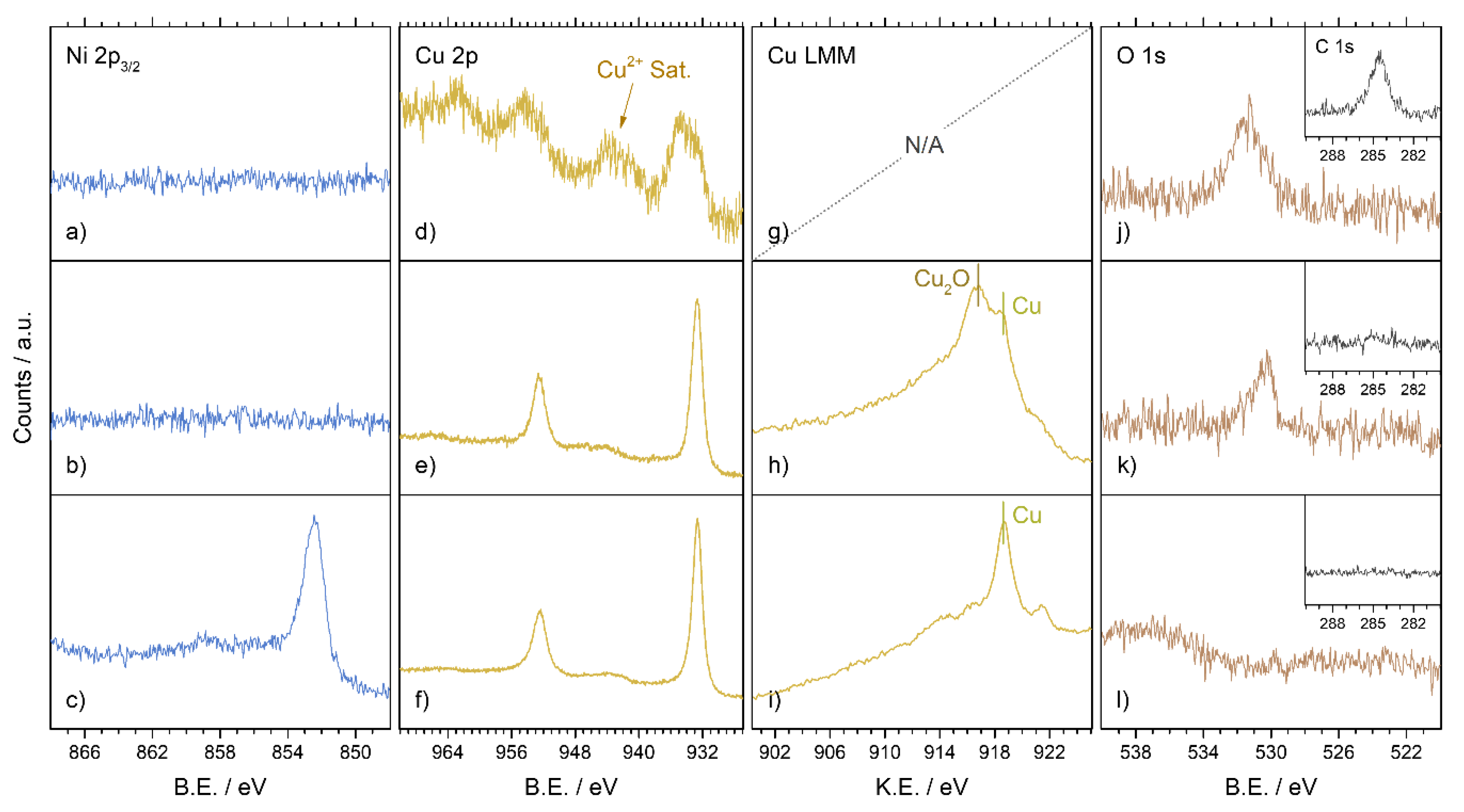


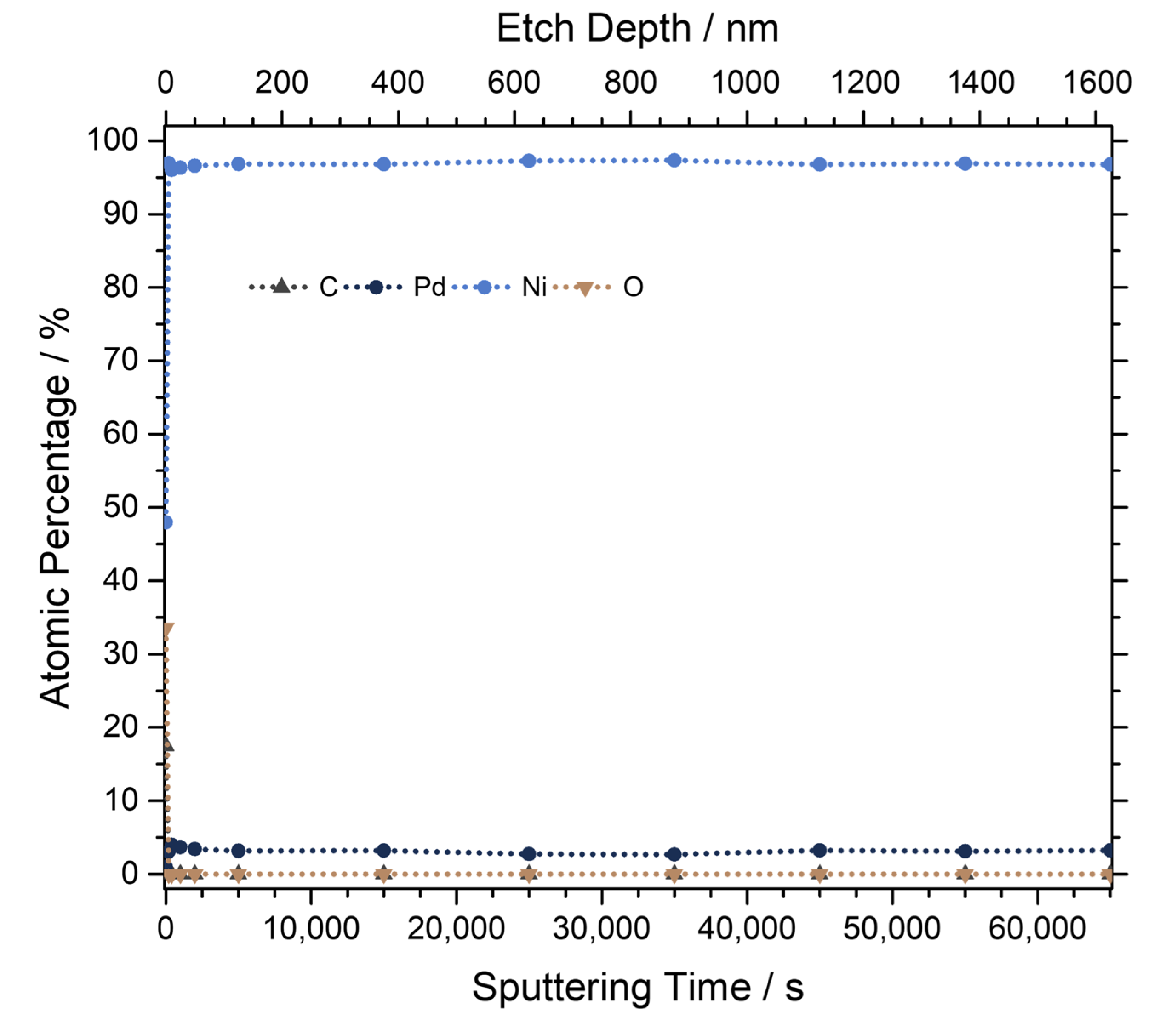
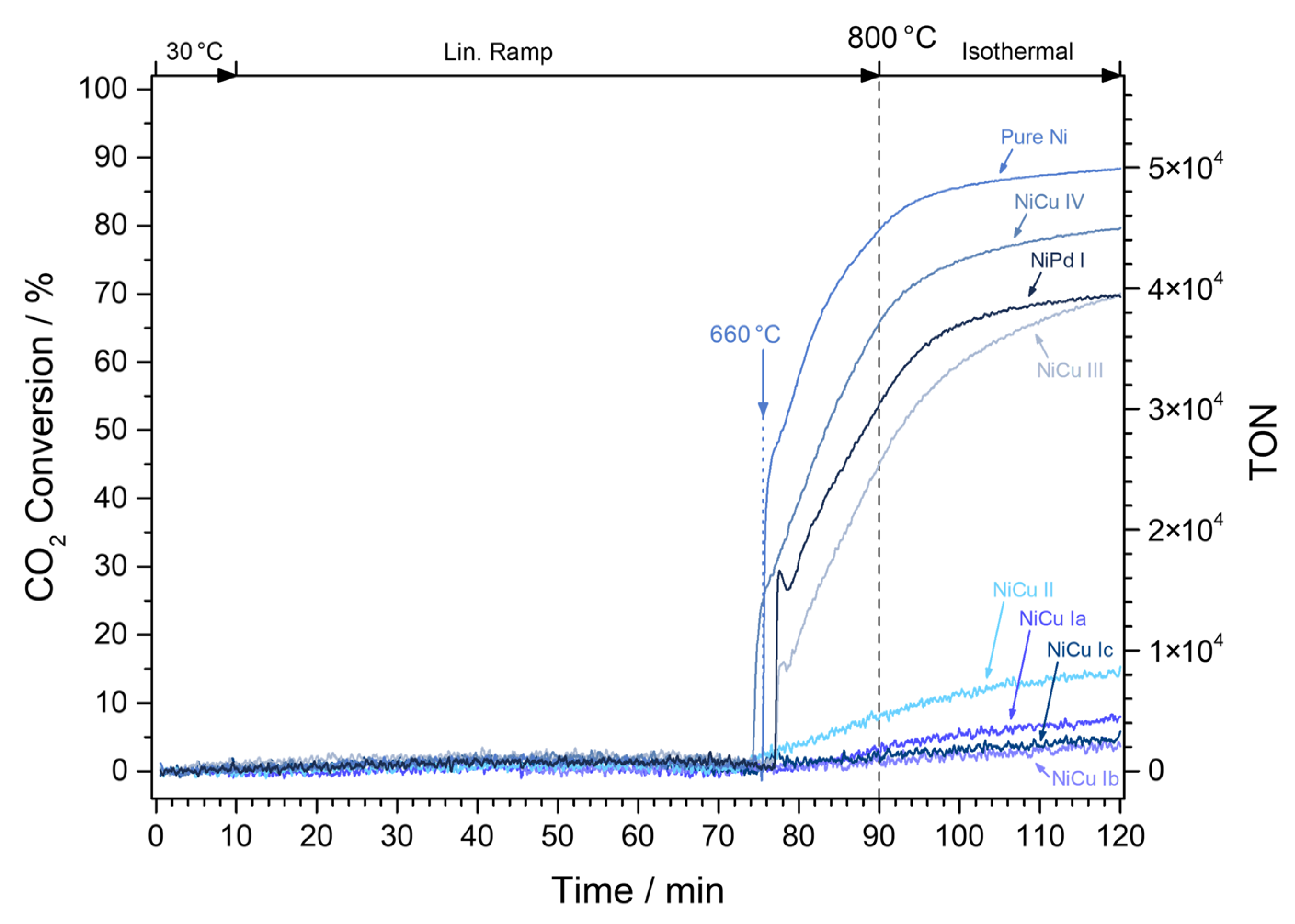
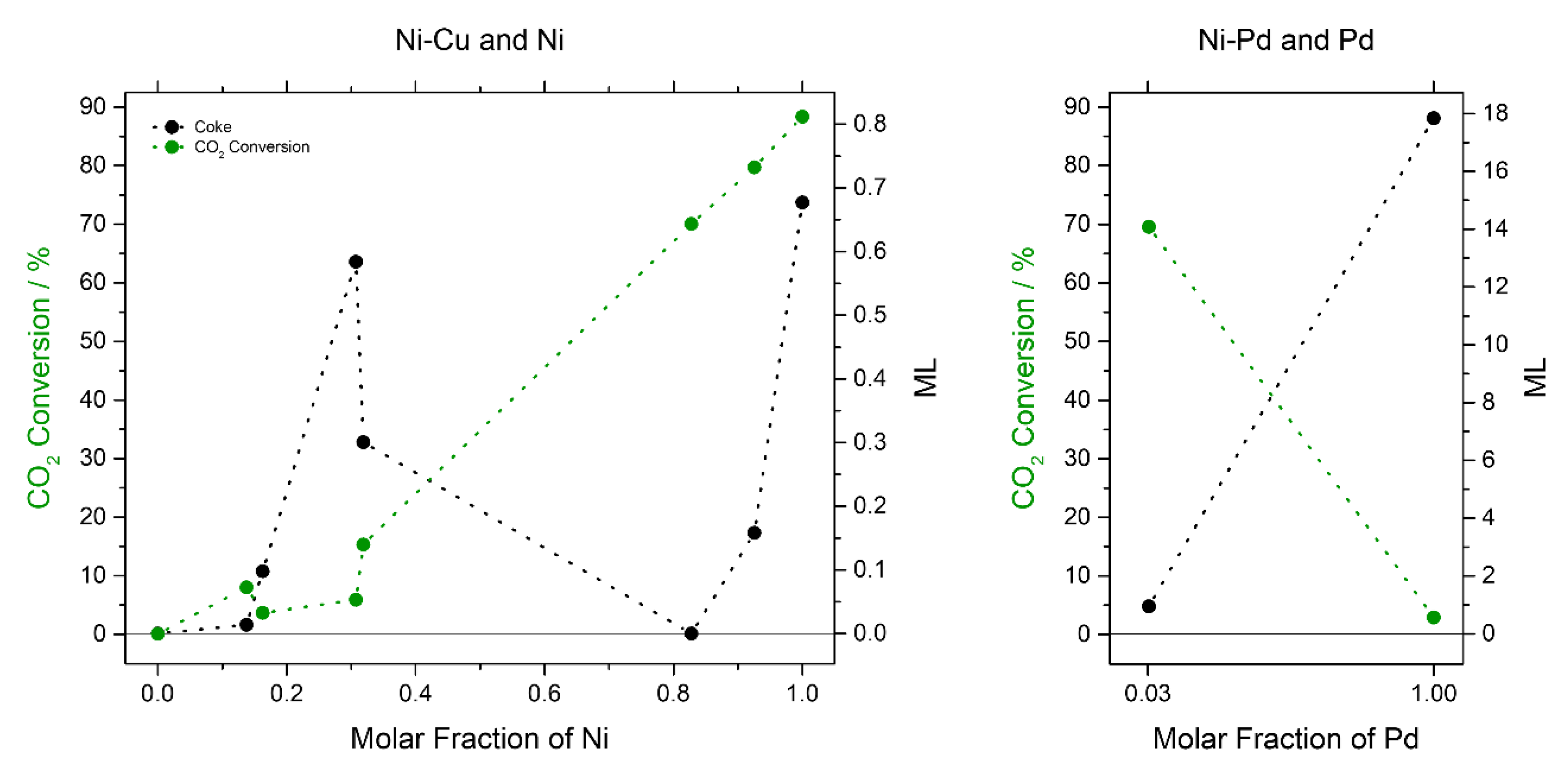
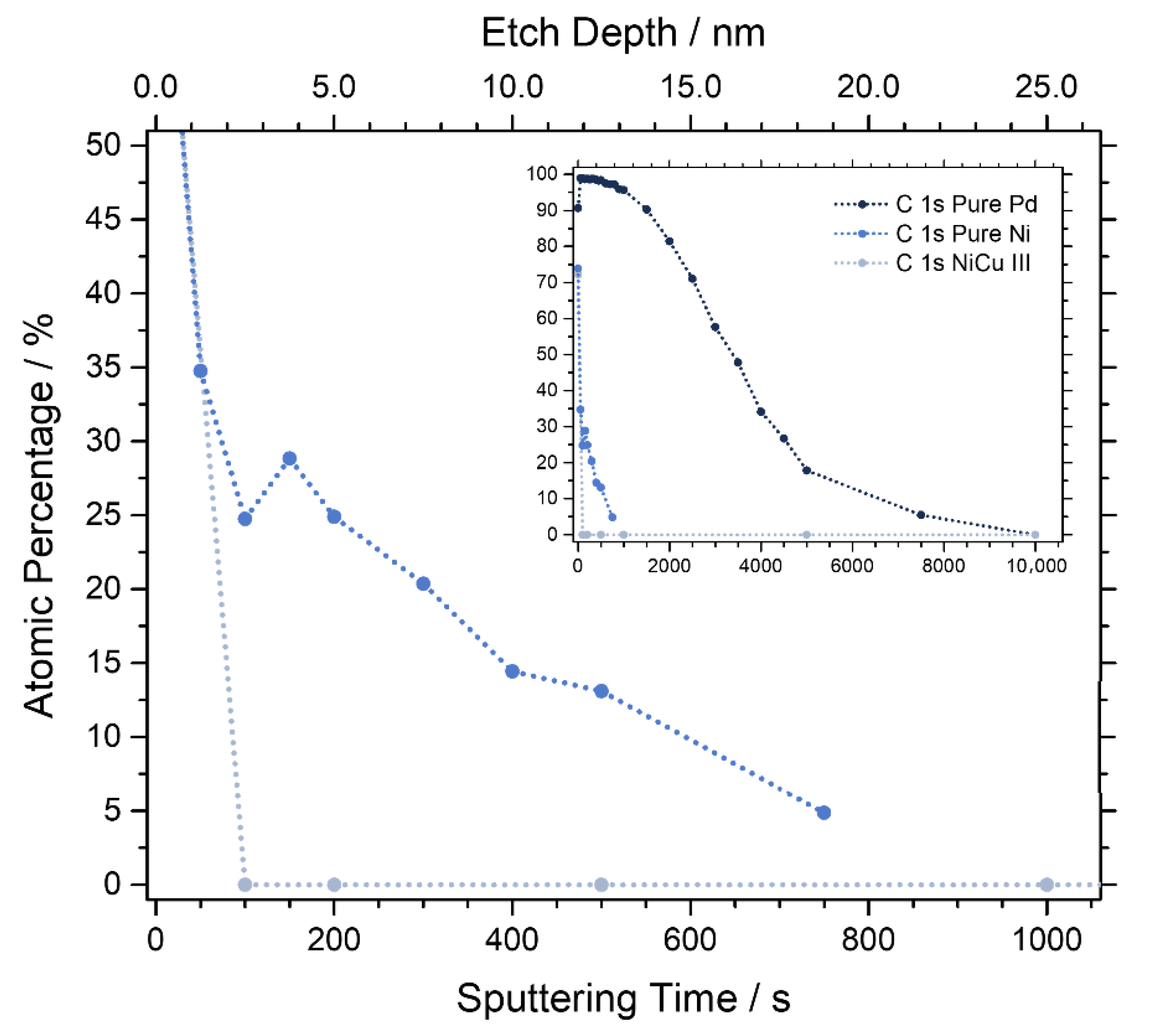
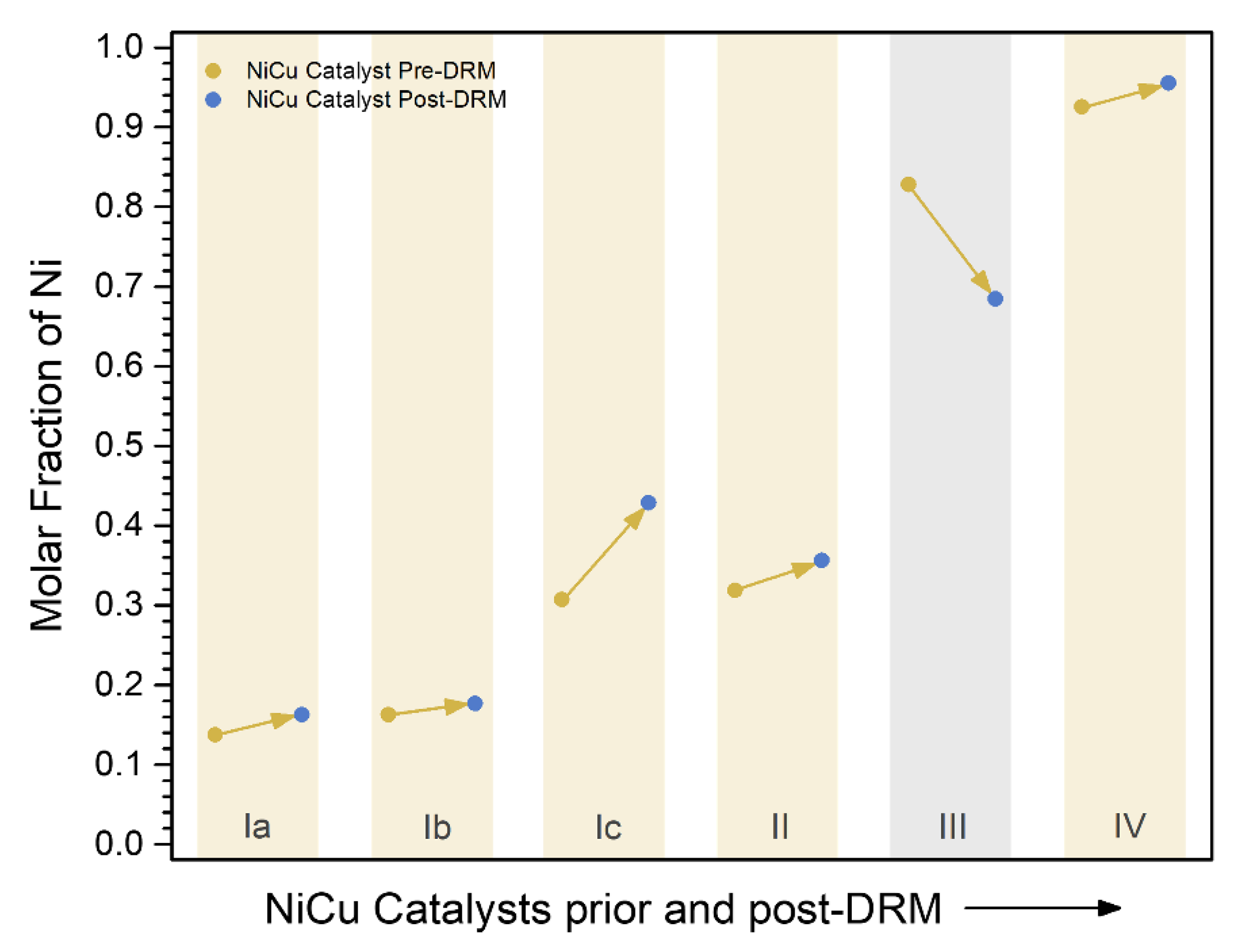

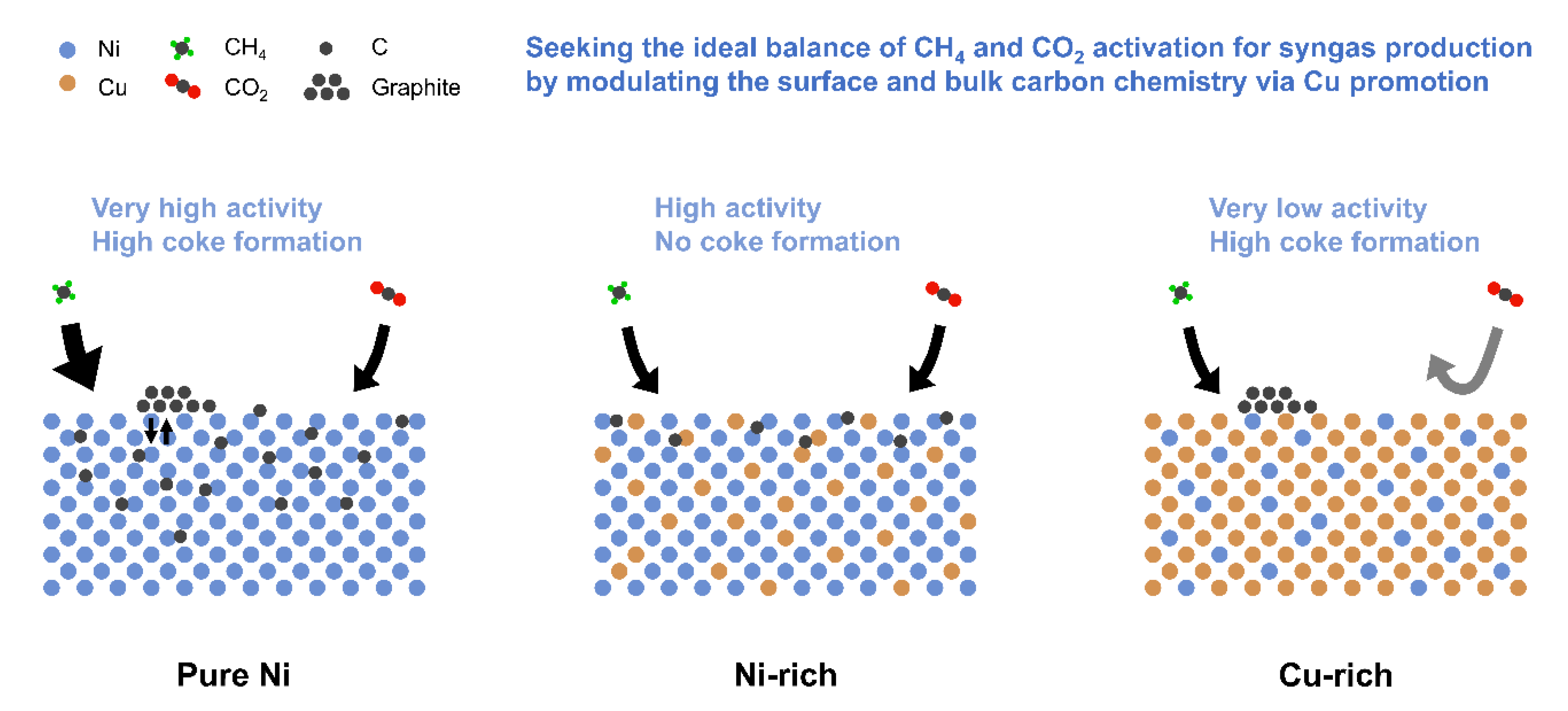
| Molar Fraction | |
|---|---|
| Sample | Ni |
| NiCu Ia | 0.1376 |
| NiCu Ib | 0.1628 |
| NiCu Ic | 0.3074 |
| NiCu II | 0.3188 |
| NiCu III | 0.8280 |
| NiCu IV | 0.9257 |
| TOF/s−1 | |||
|---|---|---|---|
| Sample | at 100 min | at 110 min | at 115 min |
| NiCu III | 8.2 | 5.2 | 3.9 |
| NiCu IV | 4.6 | 1.9 | 1.8 |
| Pure Ni | 2.5 | 1.3 | 1.0 |
| NiPd I | 5.1 | 2.1 | 1.8 |
| Molar Fraction | ||||
| Sample | Ni | Carbon ML | CO2 Conversion/% | TOF/s−1 |
| Pure Cu | 0.0000 | 0.0000 | 0.06 | - |
| NiCu Ia | 0.1376 | 0.0137 | 8.00 | - |
| NiCu Ib | 0.1628 | 0.0978 | 3.65 | - |
| NiCu Ic | 0.3074 | 0.5841 | 5.88 | - |
| NiCu II | 0.3188 | 0.3006 | 15.32 | - |
| NiCu III | 0.8280 | 0.0000 | 70.07 | 5.2 |
| NiCu IV | 0.9257 | 0.1584 | 79.70 | 1.9 |
| Pure Ni | 1.0000 | 0.6771 | 88.36 | 1.3 |
| Molar Fraction | ||||
| Sample | Pd | Carbon ML | CO2 Conversion/% | TOF/s−1 |
| NiPd I | 0.0335 | 0.9496 | 69.57 | 2.1 |
| Pure Pd | 1.0000 | 17.84 | 2.92 | - |
| Molar Fraction of Ni | |||
|---|---|---|---|
| Sample | Prior DRM | Post-DRM 1 | Post-DRM 2 |
| NiCu Ia | 0.1376 | 0.1628 | - |
| NiCu Ib | 0.1628 | 0.1770 | - |
| NiCu Ic | 0.3074 | 0.4287 | - |
| NiCu II | 0.3188 | 0.3565 | 0.5309 |
| NiCu III | 0.8280 | 0.6846 | 0.7645 |
| NiCu IV | 0.9257 | 0.9556 | - |
Publisher’s Note: MDPI stays neutral with regard to jurisdictional claims in published maps and institutional affiliations. |
© 2022 by the authors. Licensee MDPI, Basel, Switzerland. This article is an open access article distributed under the terms and conditions of the Creative Commons Attribution (CC BY) license (https://creativecommons.org/licenses/by/4.0/).
Share and Cite
Zambaldi, P.; Haug, L.; Penner, S.; Klötzer, B. Dry Reforming of Methane on NiCu and NiPd Model Systems: Optimization of Carbon Chemistry. Catalysts 2022, 12, 311. https://doi.org/10.3390/catal12030311
Zambaldi P, Haug L, Penner S, Klötzer B. Dry Reforming of Methane on NiCu and NiPd Model Systems: Optimization of Carbon Chemistry. Catalysts. 2022; 12(3):311. https://doi.org/10.3390/catal12030311
Chicago/Turabian StyleZambaldi, Philipp, Leander Haug, Simon Penner, and Bernhard Klötzer. 2022. "Dry Reforming of Methane on NiCu and NiPd Model Systems: Optimization of Carbon Chemistry" Catalysts 12, no. 3: 311. https://doi.org/10.3390/catal12030311
APA StyleZambaldi, P., Haug, L., Penner, S., & Klötzer, B. (2022). Dry Reforming of Methane on NiCu and NiPd Model Systems: Optimization of Carbon Chemistry. Catalysts, 12(3), 311. https://doi.org/10.3390/catal12030311







